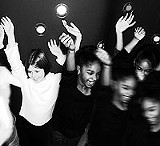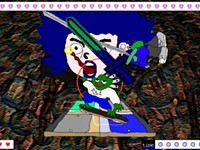[
{
"name": "500x250 Ad",
"insertPoint": "5",
"component": "15667920",
"parentWrapperClass": "",
"requiredCountToDisplay": "1"
}
]
A trip to a museum with children is a microcosm of parenting. You want your kids to have fun while they learn, of course. But you don't want them running all over the place knocking stuff down while they're at it. So how to maintain control while still giving them freedom?
I can't help you with the parenting question, but I can guide you to a museum exhibition designed specifically for children to explore on their own. Cool Moves! The artistry of motion, at the Rochester Museum and Science Center through June 22, has 15 stations that reveal different aspects of motion --- chaos vs. patterns, vibration vs. linear, repeating vs. nonrepeating, etc. With two tornados that kids can manipulate, a ripple tank that throws shadow patterns onto the floor, and a wall of motion-triggered lights, this is one exhibit that allows parents to take a back seat as kids lead the learning.
The show has almost no signage, which at first I thought was an oversight. In the past decade, museum labels and wall text have bulked up like an athlete on steroids. Remember when a small label containing key information about the object, date, and country sufficed? Now it seems every painting, dinosaur bone, and computer model in every museum comes with a mini-thesis that I, as a dutiful parent, feel required to read out loud as my bored children fidget.
I ran along behind my two sons and their friends as they approached the exhibit, in case they had questions. While I was looking for a label to read, the kids got right to work without me. The 6-year-old and his friend were drawn to the cars with crazy wheels on an adjustable track. They were busily putting gear-edged wheels on one car, smooth on the other, when I came over eager to help. "Which wheels will make the cars go faster--?" I began.
"Look out!" my son said, zooming them down the track. "Bumpy tires lose!" It seemed I wasn't needed.
This is exactly what exhibit designers planned, says Calvin Uzelmeier, who helped develop Cool Moves. The label copy is minimal, he says, because they wanted to encourage all kinds of play.
"The exhibition is designed for a lot of open experimentation," Uzelmeier says. "It's about appreciating the forms of motion, not just the physics but the inherent aesthetics, the way it moves, the way it sounds." This is unlike traditional science museum displays, where the viewer's interaction is scripted. "We're not telling you to push this button, turn this knob, and you'll see what it does," he says. "There's infinite possibilities in each one."
But still, wasn't I the mother? Wasn't I supposed to be teaching the kids about what they were learning? I trailed after my 9-year-old, who was working with a pendulum and several large magnets. "Pendulums swing back and forth," I said, feeling like I had to say something, however idiotic. But he didn't hear me; he was completely absorbed in moving the magnets and watching the pendulum swing in wild reaction to them. Not only was he learning without me, he could teach me a thing or two.
Uzelmeier has seen my brand of over-involved parenting before, and tries to be gentle in his assessment of it. "Parents want to tell their kids 'This is what this is about.' They are afraid of learning through play," he says, blaming the rigid way science was taught years ago. "There is a lot of learning that can be done when you give children the freedom to play."
While there's nothing new about the concept of hands-on learning, this show goes several steps farther than most. With its pared-down signage, wide-open possibilities, and emphasis on accessibility, it really engages children. And that's no accident.
The Cool Moves designers --- a team of educators and scientists from the RMSC and the Sciencenter in Ithaca --- tried out each station on children and then brought them back to the lab for improvement.
For example, the first station in the exhibit has four globes of swirling green liquid on pedestals. "When we tested it on some children, we noticed that they stood in the middle of the globes and looked at them," Uzelmeier says. "They were waiting for something to happen." The team added lights. "Now when you stand in between the four globes and step on small floor pads, the globes light up," he says.
My children and their friends loved jumping on the pads and watching the orbs light up. Everyone wanted to know what they were filled with and I, in a break from my traditional role as all-knowing parent, didn't try to make something up.
Nothing about Cool Moves is static, not even the show itself. Even after installing it, the team continued to make changes. "We still spend time watching the visitors, talking to them," Uzelmeier says. So many teachers requested information about the science of motion that the team had a video made. It runs continuously in the exhibit.
Even the exhibition's minimal signage is subject to change, if visitors request more information. Right now there is one question the team hears constantly. "We might have to make up one more little sign," Uzelmeier says, "that explains what's in the orbs."
Cool Moves! The artistry of motion, at the Rochester Museum and Science Center through June 22. 271-1880, www.rmsc.org.
Speaking of RMSC, Cool Moves
-

Where to celebrate Saturday’s partial eclipse
Oct 13, 2023 -

Midwinter family activities to cure cabin fever
Feb 25, 2022 -

It's gut check time at FLX Fermentation Festival this weekend
Aug 12, 2021 - More »
Latest in Culture
More by Jennifer Loviglio
-
The XX Files
Nov 15, 2006 -

Silent (politically correct) night
Nov 15, 2006 -
Escape to Jennitopia
Nov 1, 2006 - More »



